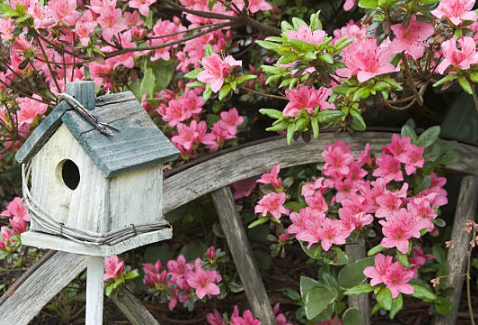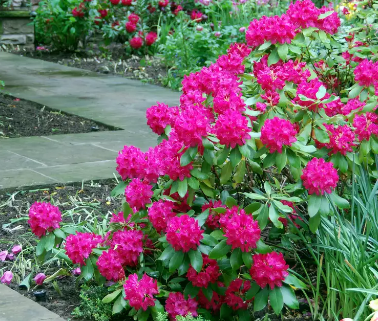Azaleas bring vibrant color and texture to any garden. These long-lived evergreen shrubs adapt well to most climates and provide year-round interest. Whether you’re adding them to a woodland setting, using them as foundation plantings, or creating privacy screens, there’s an azalea variety perfect for your landscape.
How to Incorporate Azaleas into Your Landscape
When choosing azaleas for your garden, consider the plant’s mature size, leaf texture and color, bloom time, and flower color. Azaleas work well in both formal gardens and more natural settings.
While all azaleas belong to the Rhododendron genus, this guide focuses on evergreen azaleas and their hybrids. These typically have bell-shaped flowers in clusters, each with five lobes and ten stamens. The leaves are glossy, thick, dark green, oval-shaped, and leathery.
1. As Foundation Plantings
Azaleas make excellent foundation shrubs. Their foliage provides year-round interest, and they can be planted in masses or mixed with other shrubs. When choosing a variety, consider how the bloom color complements your home’s exterior and note the plant’s mature height.

Great low-growing options include:
-
Carolina Azalea (R. carolinianum): Grows 3–6 feet tall and wide in 10 years. Blooms in soft rose-lavender, white, or pale pink in late spring.
-
Chapman’s Azalea (R. chapmanii): Grows 3–5 feet tall in 10 years. Rounded pale pink to rose flowers. Heat-tolerant—great for southern-facing beds.
-
Azalea ‘Northern Starburst’: Grows 4 feet tall and wide. Notable for its burgundy foliage and large pink blooms.
-
Azalea ‘PJM Hybrid Group’: Grows 4 feet tall and wide with mahogany evergreen leaves and a range of flower colors—pink, rose, magenta, lavender, or white.
2. For Privacy Screening
Thanks to their dense evergreen foliage, azaleas are ideal for creating living privacy screens. Their spring blooms also add charm and beauty. When selecting screening varieties, keep the mature size in mind.
Top choices include:
-
‘Roseum Elegans’ (Catawba Rhododendron): Grows 6–8 feet tall and wide; produces light purple blooms.
-
Great Rhododendron (R. maximum): Also known as rosebay, one of the largest rhododendrons, reaching up to 15 feet tall and 12 feet wide. Blooms in white or pale pink in late spring.
-
‘English Roseum’ Rhododendron: Grows 6–8 feet tall with large deep pink flowers.
3. In Mixed Borders or Beds
Azaleas make stunning additions to mixed flower beds, especially along walkways or in low borders. They bloom in late spring, and their structure and foliage look great year-round.
They’re perfect companions for spring bulbs like daffodils, tulips, and snowdrops. In summer, pair them with hostas for a textural contrast, and in fall, plant chrysanthemums nearby for added seasonal color.

Larger azaleas also work well along fences or as a soft backdrop to hardscapes like ponds or patios.
4. In Woodland Settings
Because azaleas thrive in dappled shade, they’re an ideal choice for woodland gardens. Their evergreen foliage adds winter interest, and their flowers offer pops of color that contrast beautifully with bark and leaves.
5. As Potted Plants
If garden space is limited, azaleas can also be grown in containers. Since they are shallow-rooted shrubs, choose wide rather than deep pots. Use a container about twice the size of the nursery pot and fill it with soil designed for acid-loving plants. Opt for dwarf varieties such as:
-
Azalea ‘Peter J. Mezzitt’: A compact evergreen azalea ideal for containers. In mid-spring, it produces clusters of fragrant violet flowers. New leaves emerge light blue-green, mature to smooth olive green, and turn coppery in winter.
-
R. yakushimanum ‘Yaku Sunrise’: Features dark green, slightly curled leaves with fuzzy undersides. Flowers are magenta-edged with white throats.
-
Azalea ‘Ginny Gee’: Produces dense pink to white blooms in mid-spring. Stays compact at just 2 feet tall.
Tips for Planting Azaleas
Color Palette
Azalea blooms are typically white, pink, purple, or red, with rare cream or yellow varieties also available. Choose varieties that complement other plants blooming at the same time. Also, consider year-round leaf color when selecting your plants.
Bloom Time
Most azaleas bloom in mid to late spring, though some, like R. maximum, bloom in summer. Your USDA Hardiness Zone will influence bloom timing.
Height
While azaleas tend to grow slowly, always check the mature height on the nursery tag to ensure the plant fits your space. Refer to the guidance above for choosing the right variety for foundations, screens, beds, or pots.
Companion Plants
As azaleas mature, their lower stems may become bare. Add low-growing evergreens, ornamental grasses, or flowering plants around their base to help keep the planting full and attractive.

